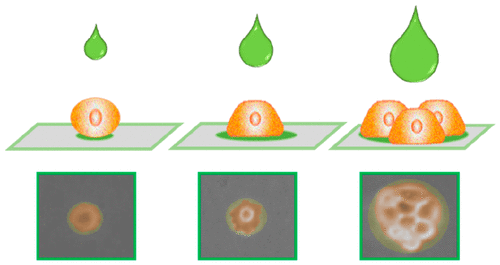当前位置:
X-MOL 学术
›
ACS Biomater. Sci. Eng.
›
论文详情
Our official English website, www.x-mol.net, welcomes your
feedback! (Note: you will need to create a separate account there.)
Aqueous Processed Biopolymer Interfaces for Single-Cell Microarrays
ACS Biomaterials Science & Engineering ( IF 5.4 ) Pub Date : 2020-04-06 , DOI: 10.1021/acsbiomaterials.9b01871 Vittorio Ferrara 1 , Giovanni Zito 2 , Giuseppe Arrabito 3 , Sebastiano Cataldo 3 , Michelangelo Scopelliti 3 , Carla Giordano 2 , Valeria Vetri 3 , Bruno Pignataro 3
ACS Biomaterials Science & Engineering ( IF 5.4 ) Pub Date : 2020-04-06 , DOI: 10.1021/acsbiomaterials.9b01871 Vittorio Ferrara 1 , Giovanni Zito 2 , Giuseppe Arrabito 3 , Sebastiano Cataldo 3 , Michelangelo Scopelliti 3 , Carla Giordano 2 , Valeria Vetri 3 , Bruno Pignataro 3
Affiliation

|
Single-cell microarrays are emerging tools to unravel intrinsic diversity within complex cell populations, opening up new approaches for the in-depth understanding of highly relevant diseases. However, most of the current methods for their fabrication are based on cumbersome patterning approaches, employing organic solvents and/or expensive materials. Here, we demonstrate an unprecedented green-chemistry strategy to produce single-cell capture biochips onto glass surfaces by all-aqueous inkjet printing. At first, a chitosan film is easily inkjet printed and immobilized onto hydroxyl-rich glass surfaces by electrostatic immobilization. In turn, poly(ethylene glycol) diglycidyl ether is grafted on the chitosan film to expose reactive epoxy groups and induce antifouling properties. Subsequently, microscale collagen spots are printed onto the above surface to define the attachment area for single adherent human cancer cells harvesting with high yield. The reported inkjet printing approach enables one to modulate the collagen area available for cell attachment in order to control the number of captured cells per spot, from single-cells up to double- and multiple-cell arrays. Proof-of-principle of the approach includes pharmacological treatment of single-cells by the model drug doxorubicin. The herein presented strategy for single-cell array fabrication can constitute a first step toward an innovative and environmentally friendly generation of aqueous-based inkjet-printed cellular devices.
中文翻译:

单细胞微阵列的水处理生物聚合物界面
单细胞微阵列是揭示复杂细胞群体内在多样性的新兴工具,为深入了解高度相关疾病开辟了新方法。然而,目前大多数的制造方法都是基于繁琐的构图方法,采用有机溶剂和/或昂贵的材料。在这里,我们展示了一种史无前例的绿色化学策略,可以通过全水性喷墨印刷在玻璃表面上生产单细胞捕获生物芯片。首先,可以容易地喷墨印刷壳聚糖膜,并通过静电固定将其固定在富含羟基的玻璃表面上。继而,将聚乙二醇二缩水甘油醚接枝到壳聚糖膜上,以暴露反应性环氧基并诱导防污性能。后来,将微尺度的胶原蛋白斑点印在上面的表面上,以限定附着区域,以高产率收获单个附着的人类癌细胞。所报道的喷墨打印方法使人们能够调节可用于细胞附着的胶原蛋白区域,以便控制每个点捕获的细胞数量,从单细胞到双细胞和多细胞阵列。该方法的原理证明包括通过模型药物阿霉素对单细胞进行药物治疗。本文提出的用于单电池阵列制造的策略可以构成朝着创新和环保的方式产生基于水的喷墨打印蜂窝设备的第一步。所报道的喷墨打印方法使人们能够调节可用于细胞附着的胶原蛋白区域,以便控制每个点捕获的细胞数量,从单细胞到双细胞和多细胞阵列。该方法的原理证明包括通过模型药物阿霉素对单细胞进行药物治疗。本文提出的用于单电池阵列制造的策略可以构成朝着创新和环保的方式产生基于水的喷墨打印蜂窝设备的第一步。所报道的喷墨打印方法使人们能够调节可用于细胞附着的胶原蛋白区域,以便控制每个点捕获的细胞数量,从单细胞到双细胞和多细胞阵列。该方法的原理证明包括通过模型药物阿霉素对单细胞进行药物治疗。本文提出的用于单电池阵列制造的策略可以构成朝着创新和环保的方式产生基于水的喷墨印刷蜂窝设备的第一步。
更新日期:2020-04-06
中文翻译:

单细胞微阵列的水处理生物聚合物界面
单细胞微阵列是揭示复杂细胞群体内在多样性的新兴工具,为深入了解高度相关疾病开辟了新方法。然而,目前大多数的制造方法都是基于繁琐的构图方法,采用有机溶剂和/或昂贵的材料。在这里,我们展示了一种史无前例的绿色化学策略,可以通过全水性喷墨印刷在玻璃表面上生产单细胞捕获生物芯片。首先,可以容易地喷墨印刷壳聚糖膜,并通过静电固定将其固定在富含羟基的玻璃表面上。继而,将聚乙二醇二缩水甘油醚接枝到壳聚糖膜上,以暴露反应性环氧基并诱导防污性能。后来,将微尺度的胶原蛋白斑点印在上面的表面上,以限定附着区域,以高产率收获单个附着的人类癌细胞。所报道的喷墨打印方法使人们能够调节可用于细胞附着的胶原蛋白区域,以便控制每个点捕获的细胞数量,从单细胞到双细胞和多细胞阵列。该方法的原理证明包括通过模型药物阿霉素对单细胞进行药物治疗。本文提出的用于单电池阵列制造的策略可以构成朝着创新和环保的方式产生基于水的喷墨打印蜂窝设备的第一步。所报道的喷墨打印方法使人们能够调节可用于细胞附着的胶原蛋白区域,以便控制每个点捕获的细胞数量,从单细胞到双细胞和多细胞阵列。该方法的原理证明包括通过模型药物阿霉素对单细胞进行药物治疗。本文提出的用于单电池阵列制造的策略可以构成朝着创新和环保的方式产生基于水的喷墨打印蜂窝设备的第一步。所报道的喷墨打印方法使人们能够调节可用于细胞附着的胶原蛋白区域,以便控制每个点捕获的细胞数量,从单细胞到双细胞和多细胞阵列。该方法的原理证明包括通过模型药物阿霉素对单细胞进行药物治疗。本文提出的用于单电池阵列制造的策略可以构成朝着创新和环保的方式产生基于水的喷墨印刷蜂窝设备的第一步。











































 京公网安备 11010802027423号
京公网安备 11010802027423号